 Skin Autophagy: 10 Strategies to Rejuvenate Your Skin
Skin Autophagy: 10 Strategies to Rejuvenate Your Skin
Skin autophagy is a fascinating topic that I will dive into in detail in this article. Your skin is the largest organ that serves as a protective layer and performs essential tasks for your body. The health of your skin is essential not only for your looks but for your overall health.
Your skin protects you from viruses, bacteria, and ultraviolet light (UV) from the sun. With the help of the sun, your skin produces vitamin D to serve essential functions in your body. It also helps to keep your body at an optimal temperature and help your body react to important changes around and inside you.
In this article, you will learn about your skin’s anatomy and physiology, things that can damage your skin, symptoms of skin inflammation, foods that can lead to skin damage. You will learn what autophagy is and why is it important for skin health. Finally, I will share 10 powerful strategies to rejuvenate your skin naturally.
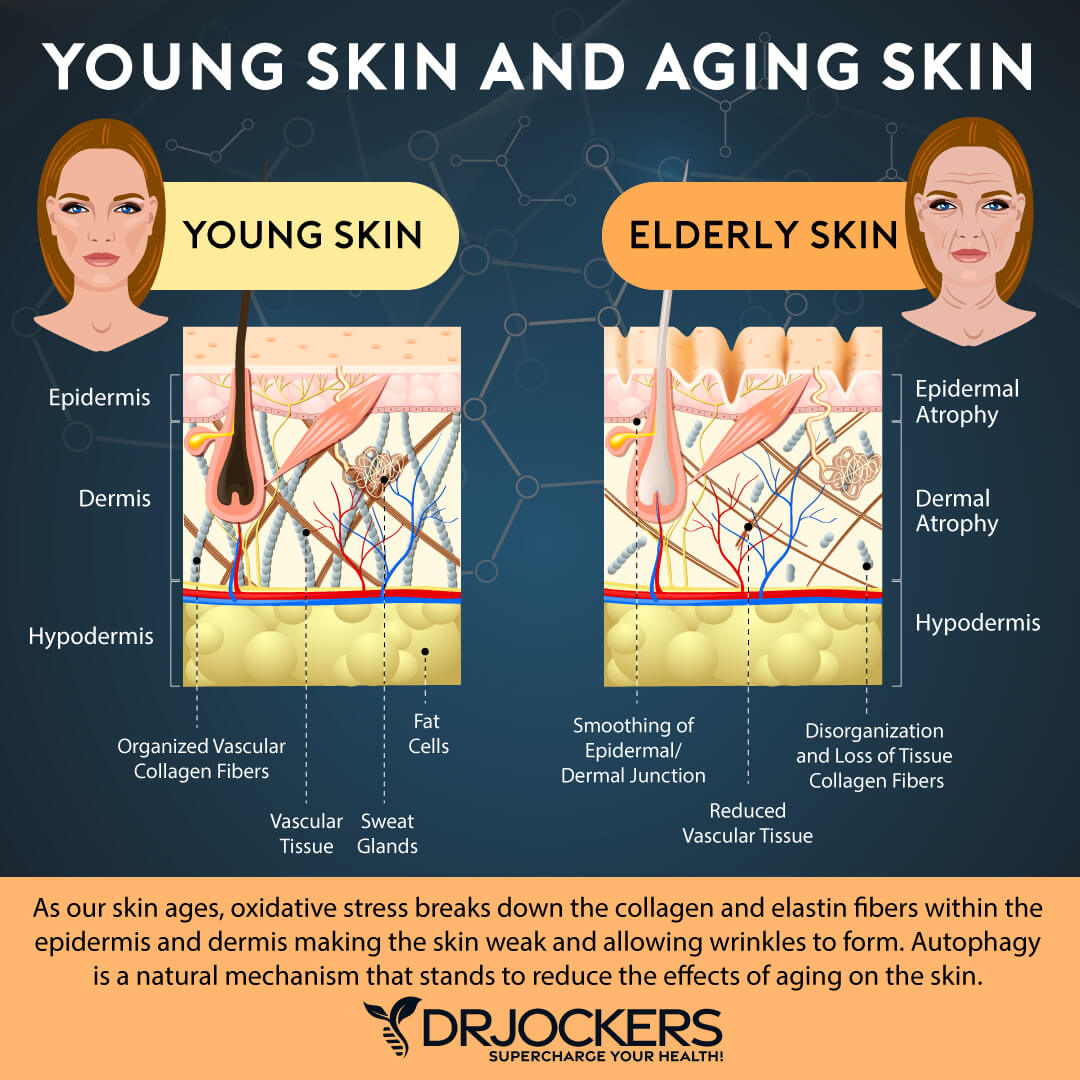
Skin Anatomy and Physiology
Your skin is your largest organ that serves as a protective barrier. Its health and surface are determined by dietary, lifestyle, and environmental factors. To understand how to keep your skin healthy, it is important to first understand its anatomy and physiology.
The three major parts of your skin include the hypodermis, dermis, and epidermis. Other parts of the skin include the sebaceous glands, elastin, collagen, dermal-epidermal junction, sebum, and blood vessels.
Epidermis
The epidermis is the outer layer of the skin. It acts as a protective barrier between your body and the environment. The stratum corneum is the outermost layer of the epidermis made up of flat, dead skin cells called corneocytes to offer an effective buffer. The basal layer is the bottom layer of the epidermis where your pigments are being produced.
Dermis
The dermis is the middle layer of your skin. It serves as your skin’s operation center that is the home of a variety of nerves, glands, enzymes, essential proteins, and blood cells. The dermis also contains collagen and elastin to provide support and structure.
Hypodermis
The hypodermis is located below the epidermis and the dermis. It is made up of fat, nerves, and blood vessels, and serves as a cushion and insulation.
Sebaceous glands
The sebaceous glands are located at the root of the hair follicles. They produce oil, or sebum, to lubricate your skin and hair.
Elastin
The elastin is an essential protein that helps your skin to stretch and bounce back after stretching. Sun exposure and repeated facial expressions both can damage the elastin which leads to sagging skin.
Collagen
Collagen is an essential protein that is basically the building blocks of your skin’s foundation. It helps your skin to have a smooth structure. Sun exposure and aging leads to the breakdown of collagen that results in fine lines and wrinkles.
Dermal-Epidermal Junction
The dermal-epidermal junction (DEJ) connects the epidermis and dermis. It hosts a network of blood vessels to help to transfer nutrients from the dermis to the epidermis.
Sebum
The sebum is an oily secretion produced by the sebaceous glands to help waterproof your skin and to keep it firm.
Blood Vessels
The network of blood vessels located in the dermis and subcutaneous layer supply oxygen and nutrients to your skins. They also help to regulate your body temperature.
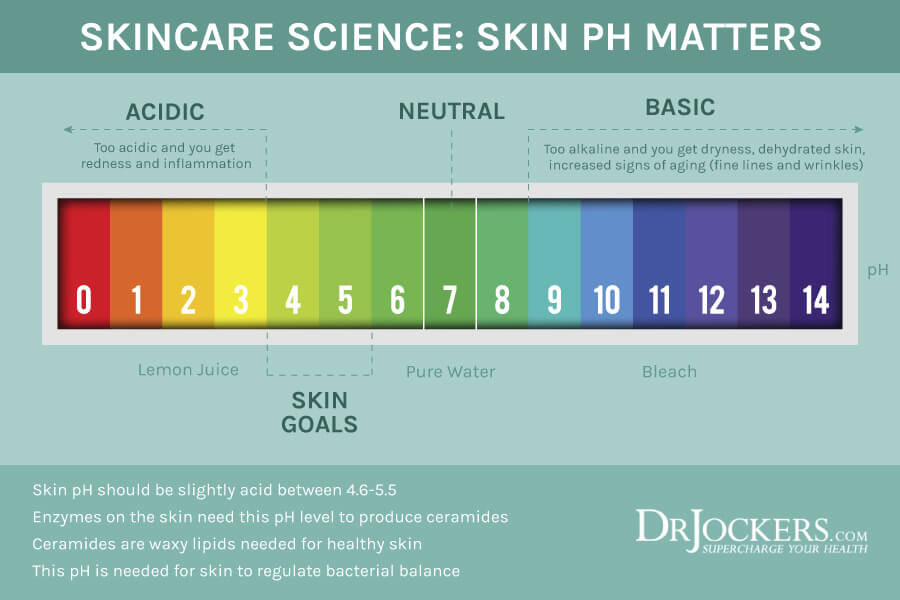
Things That Damage the Skin
There are a variety of things that can damage your skin. Toxins, radiation, inflammation, and stagnation are the top 4 problems you need to pay attention to in order to protect your skin.
Toxins and Skin Health
Toxins are unfortunately everywhere. They are in the air you breathe, conventional cleaning products, conventional body and skin care, and non-organic food. As toxins come in contact with your skin’s surface, they can lead to irritation, inflammation, and skin damage. They can also enter into your body and bloodstream through your skin and other ways. Damage that occurs inside your body, especially in your gut and hormones, can damage your skin just as much that environmental harm affecting your skin directly.
Conventional skin and body products are filled with toxic chemicals. Here are the top 10 toxins you need to watch out for that can harm your skin and overall health.
- Parabens: Parabens have been used since the 1920s and became incredibly common in products in the 1980s. However, in the past decades, research has shown that parabens an estrogenic and potentially harm your hormonal balance, damage your skin, and hurt your overall health (1).
- Sodium Lauryl Sulfates (SLS): You can find SLS in facial cleansers, body wash, shampoo, and other body products. However, SLS is a corrosive that has been used in clinical studies to irritate the skin to test various healing solutions. SLS may also result in early signs of skin aging (1).
- Phthalates: Phthalates help products to hold scent and color better. can lead to hormonal, neurological, reproductive, developmental, and skin damage (2).
- Oxybenzone: Oxybenzone is one of the ingredients of many sunscreens. However, it may actually increase the production of free radicals when exposed to light and act as a carcinogen (3).
- Lead: There is a reason we’ve stopped putting lead in paint. Lead is a proven neurotoxin linked to a variety of problems, including fertility issues and miscarriage. It may be surprising but lead has been found in many conventional lipstick brands.
- Aluminum: Aluminum is a common ingredient of antiperspirant deodorant that people apply daily. However, aluminum is also a neurotoxin that can lead to cognitive damage and other health issues.
- Triclosan: Triclosan is commonly found in hand sanitizers. However, research has shown that it can lead to hormonal damage (4).
- PEF Compounds: Polyethylene glycols (PEGS) are petroleum-based compounds found in cream-based cosmetic products. PEFS also contain ethylene oxide which is a human carcinogen that can harm your nervous system, human development, and skin.
- Hydroquinone: Hydroquinone is used in products that are used to lighten your skin and used for sun damage, acne scars, and sun damage. It is also a harmful carcinogen and it can decrease your skin’s elasticity as well (5).
- Formaldehyde: Formaldehyde is used in a variety of cosmetic products that prevent bacteria growth. It may be found in conventional body washes, shampoos, conditioners, eye shadows, nail polish, and cleanser. It is also a carcinogen that can damage your body and skin (6).
When looking for skin and body care products, avoid these chemicals. To stay safe and achieve the best results without toxic harm, choose organic, natural products or make your own products from natural ingredients. Here is a helpful article on some of the best natural beauty products

Radiation and the Skin
Exposure to ultraviolet (UV) radiation can increase your risk of skin damage and most forms of skin cancers. UV rays can damage your skin cells on a DNA level. They can compromise your skin’s immune system, lead to sunburn, wrinkles, spots, premature aging, and other damage. When the damage begins to affect skin cell growth, skin cancer starts (7, 8. 9).
While sunlight is the main and most widely known source of UV rays, tanning beds and tanning lamps are also sources of UV exposure and may lead to similar skin damage. As far as we currently know, there are no UV rays that are safe to your health.
It is important to protect yourself from UV ray radiation damage. Don’t stay out on the sun mid-day when it’s the strongest. Seek shade and protect yourself with clothing. Use natural sunscreen and apply it regularly. Avoid tanning beds and lamps (10).
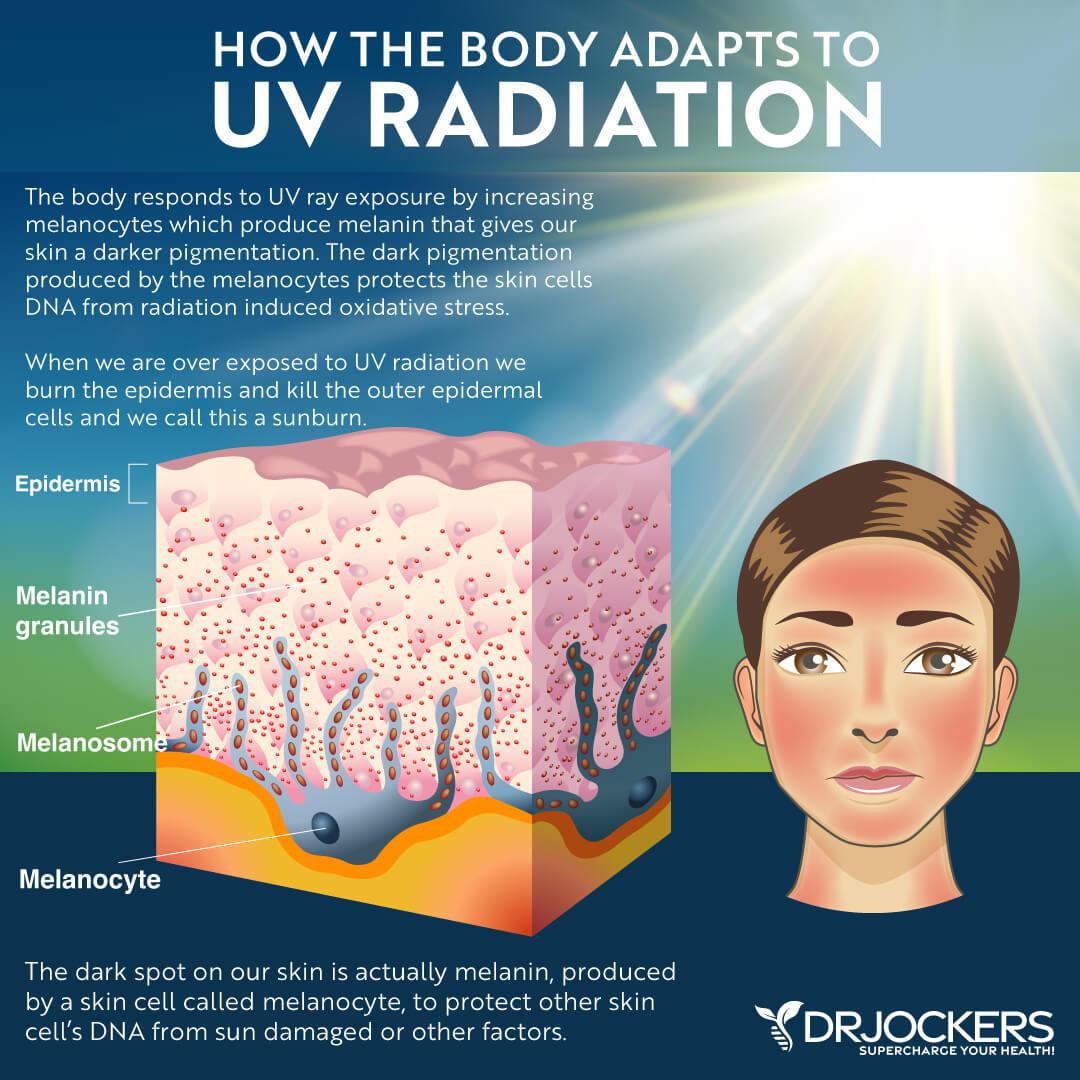
Inflammation and Skin Health
Inflammation is an important part of your body’s self-healing process. When injuries happen or invaders, such as germs, infections, and allergens, attack your body, your immune system tries to fight them off on the cellular level. Inflammation may be visible.
It can result in redness, swelling, itching, hives, or pimples as your blood vessels dilate to increase blood flow and aid healing. In the case of acute inflammation, this is a good thing. Redness, swelling, and pimples due to acute inflammation go away within a few days or weeks as your body heals.
However, when inflammation turns chronic, it becomes a problem. Eating an unhealthy diet, living an unhealthy lifestyle, chronic stress, and environmental factors can trigger your body to treat everything from processed foods to emotional stress as invaders triggering an immune response. Your body ends up believing that you are constantly under attack, creating constant inflammation. Chronic inflammation can lead to gut problems, heart disease, diabetes, Alzheimer’s, cancer, and other chronic health issues.
Chronic inflammation can also affect your skin. It can lead to chronic acne, puffiness, sagging, redness, enlarged pores, fine lines, wrinkles, and other signs of premature aging. Chronic inflammation is also the root cause of a variety of chronic skin problems, including eczema, psoriasis, and dermatitis (11).

Stagnation and Skin Health
Under ideal conditions, your skin should be at a state of flow. Your epidermis undergoes a constant renewal as all cells are replaced by new ones every 28 days. Old, dead skin layer shed without you notice it, and new ones appear. If you treat your skin and body right, this renewal process helps heal inflammation, pimples, scars, and other issues, and create glowing, healthy skin.
One of the main reasons for stagnation is the liquid plastic found in skincare products. Theoretically, these products are designed to repair skin concerns and beautify your skin, however, in long-term, they may do the opposite. Liquid plastic is a cheap solution to hide pores, fill lines, and cover brown spots. Paired with silicone they may create a silky and smooth skin.
However, these products don’t address the root cause of these skin issues. Instead of achieving true repair, they simply cover up the damage beneath the surface. Over time, they can lead to more wrinkles, dryness, acne, redness, blemishes, dark spots, and sagging.

Symptoms of Skin Inflammation
A variety of things, including bacteria, virus, and fungal infections, allergic reactions, immune system dysfunction, heat, photosensitivity, and genetics can lead to skin inflammation.
There may be a variety of symptoms of skin inflammation, including:
- Acne or pimples
- Blisters
- Eczema
- Wrinkles
- Age spots
- Rashes
- Cracked or raw skin that may bleed
- Itching, burning, or stinging
- Oozing
- Redness
- Scaliness
- Warmth in the affected area
- Thickening of the skin
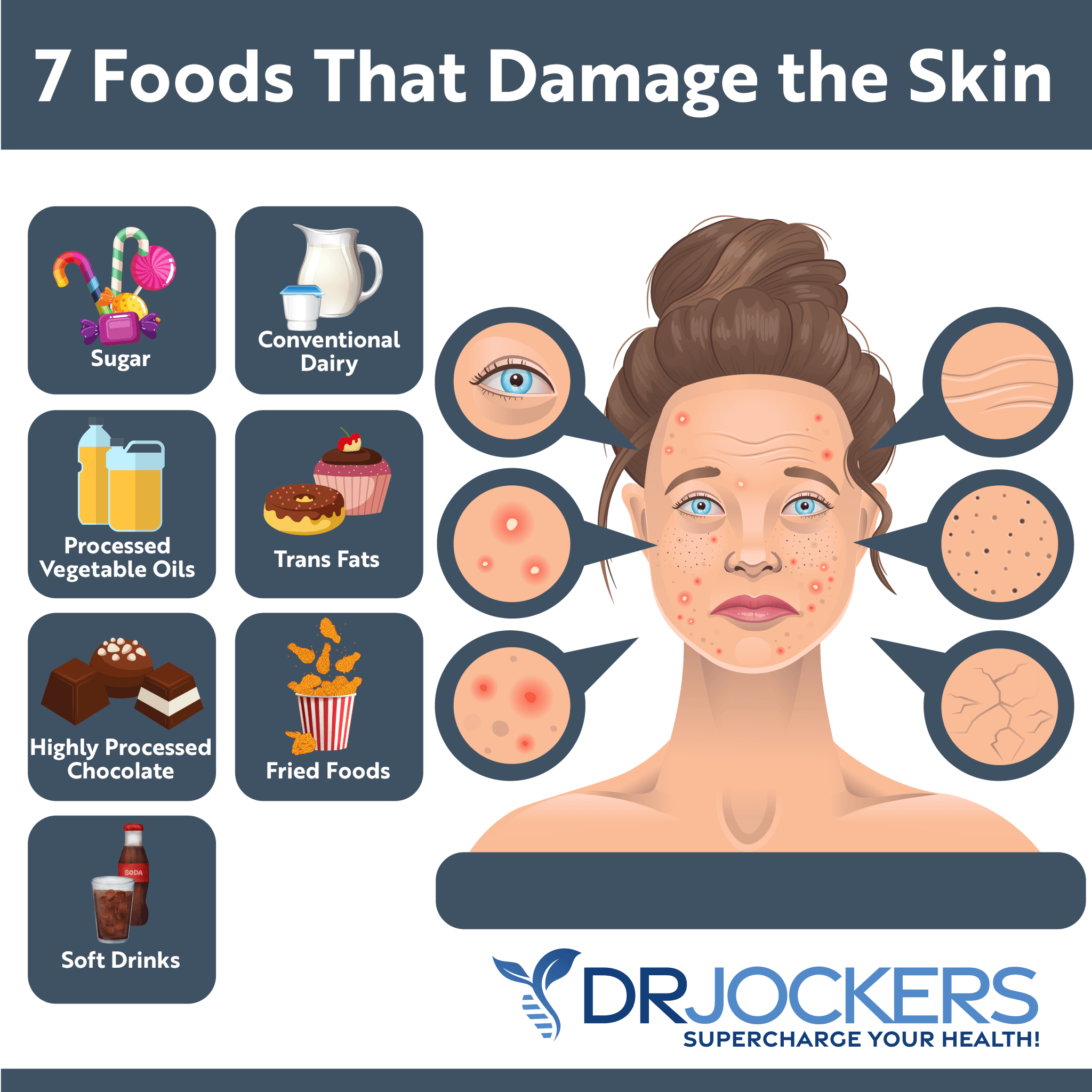
7 Foods That Damage Skin
Your diet matters. If you are eating a nutrient-dense diet, it can set you up for health and energy. On the contrary, if you consume an unhealthy diet, it can damage your overall health, including your skin. There are 7 main foods that can damage your skin.
Conventional Dairy
Conventional dairy is an inflammatory food that can worsen inflammatory skin problems, including acne, eczema, and rashes. Conventional dairy is also high in growth hormones and antibiotics that may interfere with your hormonal balance that may also lead to skin issues (15).
Moreover, about 75 percent of the world and 25 percent of the US population is lactose intolerant, and many more are sensitive to the dairy proteins casein and whey. Lactose intolerance and dairy sensitivity can trigger skin inflammation and a flare-up of skin conditions (16, 17).
Sugar
Refined sugar is the cause of an array of health problems, including inflammation, insulin resistance, diabetes, obesity, heart disease, depression, and more. Not surprisingly, sugar is not good for your skin either. Inflammation caused by sugar can break down collagen and elastin, which results in signs of early aging, wrinkles, and sagging skin.
Eating too much sugar can also result in glycation which is the process when digested sugar permanently attaches to the collagen in your skin, and can lead to skin conditions, including acne and rosacea. Too much sugar can also weaken your immune system and gut health which can lead to further skin damage (12, 13, 14).
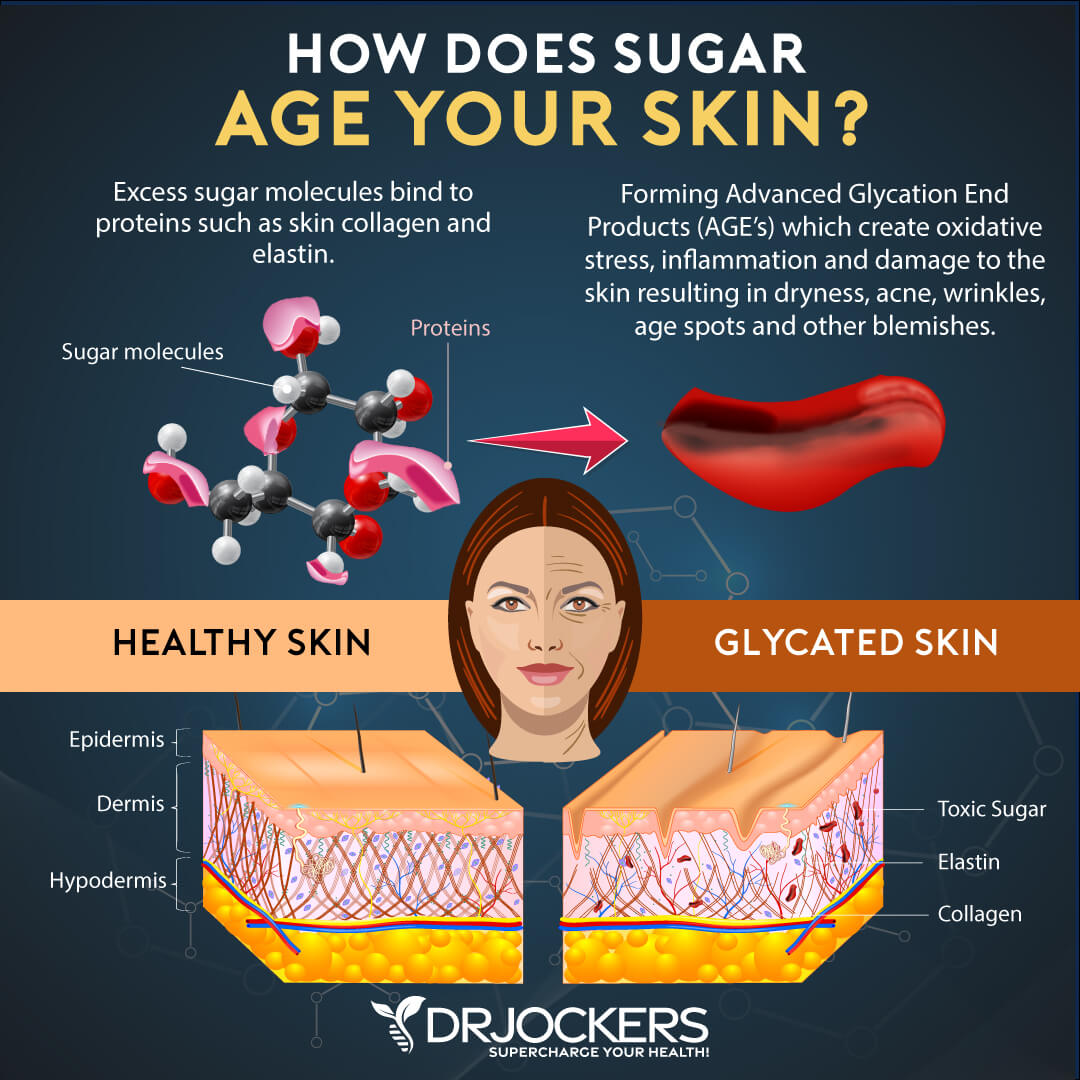
Processed Vegetable Oils
Refined vegetable oils, such as canola, corn, soybean, sunflower, sesame, rice bran, and cottonseed oils, became popular in the 20th century. They are made by extracting oil from plants using an oil mill or chemical solvent.
Often they are purified, refined, and even chemically altered. These processed oils, however, are very high in inflammatory omega-6 fatty acids that can lead to skin damage and other health issues (18).

Trans Fats
Artificial trans fats are created in an industrial process by adding hydrogen to make liquid vegetable oils more solid. They present a big problem when it comes to your skin health. Trans fats are everywhere.
The main dietary source of trans fats is partially hydrogenated oils hiding in countless processed foods, including frozen pizzas, cakes, crackers, margarine, and pie crusts. Trans fats create inflammation in your body, which leads to skin damage (19)
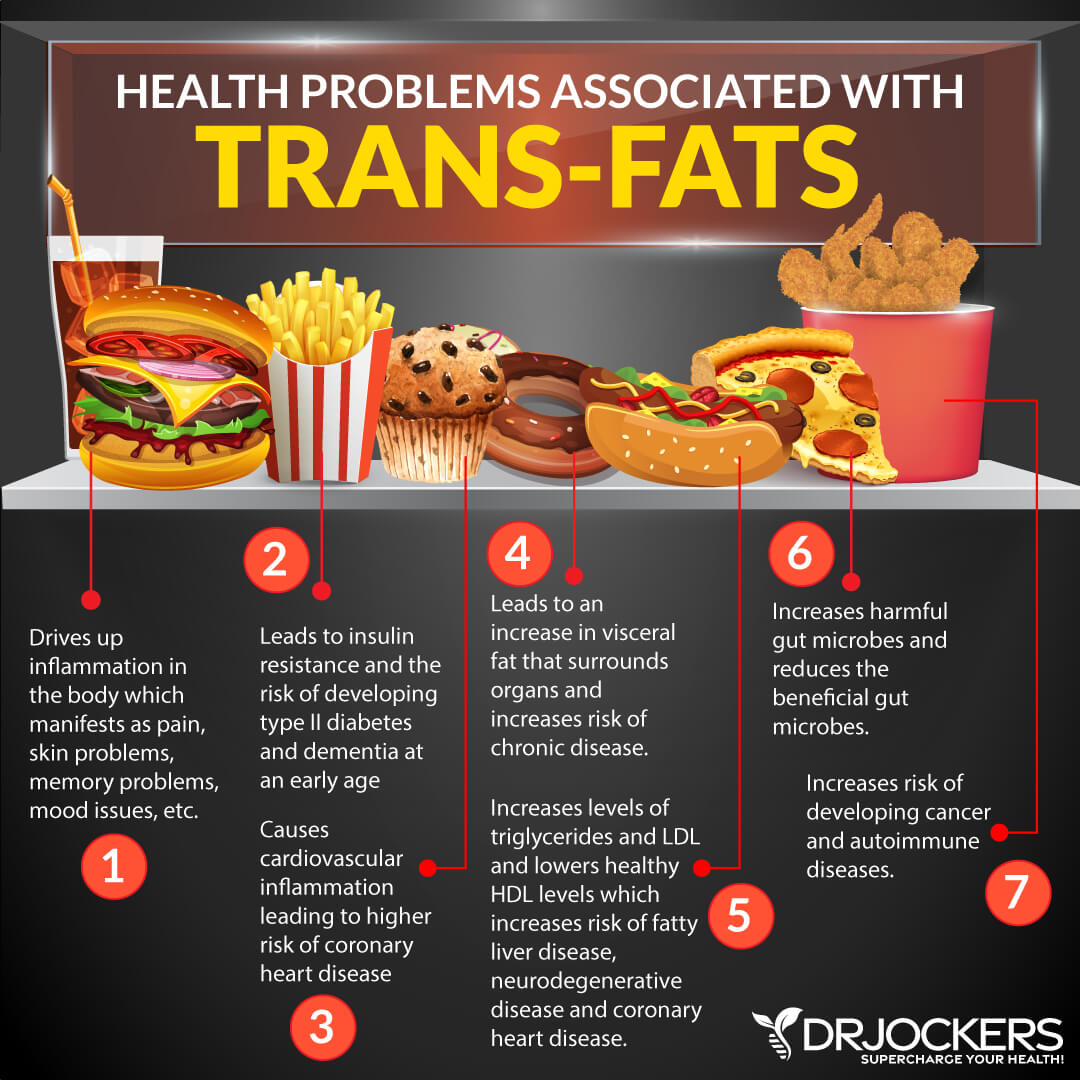
Fried Foods
Fried foods are usually deep-fried in refined vegetable oils. The problem is that these oils are loaded with trans fats. They are high inflammatory omega-6 fatty acids that can aggravate and lead to skin conditions.
When vegetable oils are heated at high heat, they oxidized. Putting oxidized fat into your body can lead to unhealthy circulation, lack of oxygen in your skin, and damaged collagen and elastin, all of which may result in signs of early aging and skin damage (21).
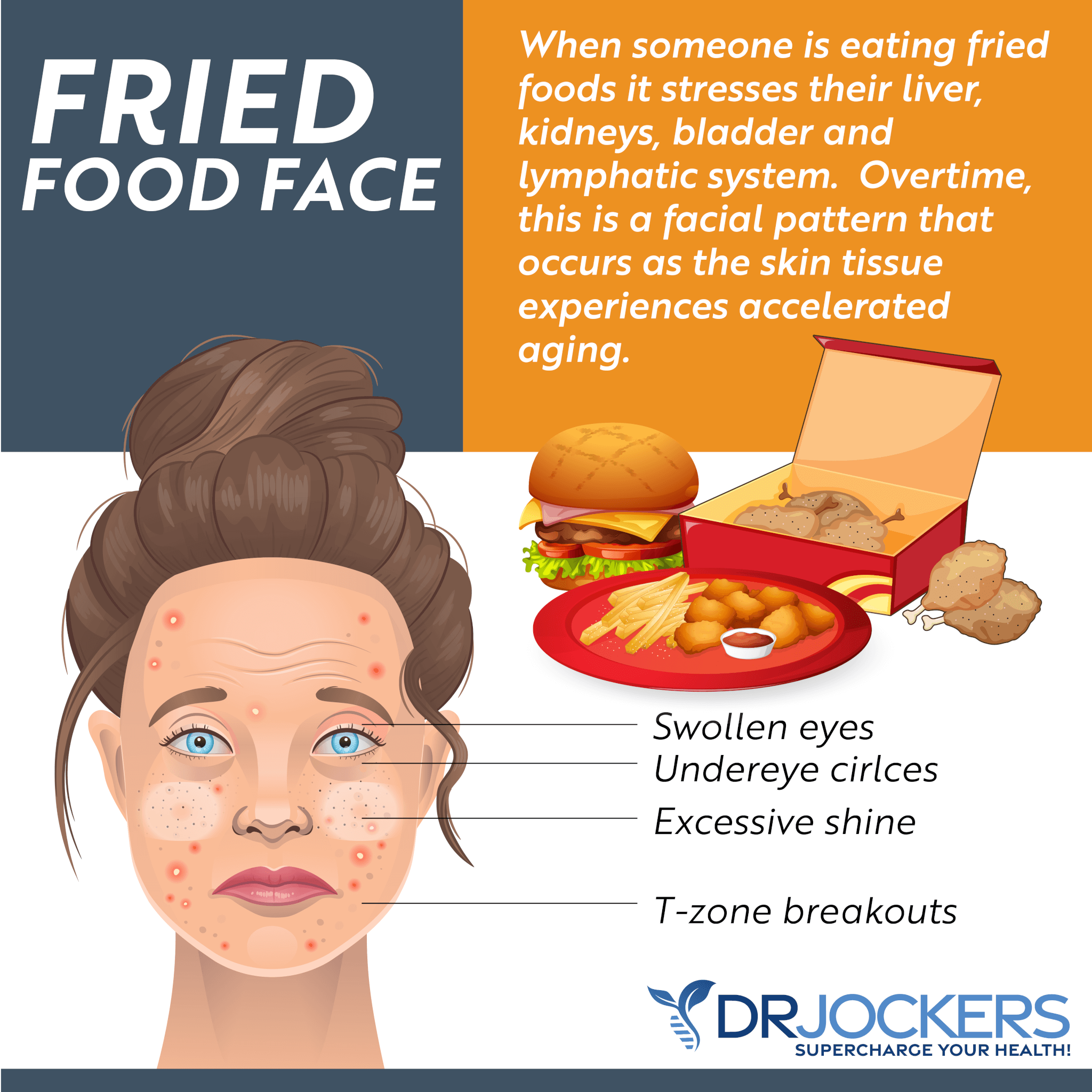
Highly Processed Chocolate
While raw cacao is high in antioxidants and can be beneficial to your health, highly processed chocolates do the opposite. Highly processed chocolate usually use alkali treated cocoa processed that is completely stripped from its flavonoid antioxidant benefits.
Not to mention that highly processed chocolates have very little cacao in them, instead, they are filled with refined sugar and additional ingredients, such as artificial flavors, soy lecithin, and cacao liquor. Highly processed chocolate offer no nutritional value, instead, it can lead to inflammation, skin damage, and health problems (20).
Soft Drinks
Soft drinks are loaded with sugar, artificial sugars, and other artificial ingredients that can lead to skin problems. Some soft drinks, including sodas and energy drinks, are caffeinated. Too much caffeine results in increased cortisol levels and excess cortisol can accelerate aging and result in fine lines, wrinkles, brown spots, dehydration, and skin damage.

What Is Autophagy
Autophagy is a process that happens when your body recycles and gets rid of old or excess cells that don’t benefit your health anymore. Autophagy helps your body to create new and healthier cellular structures. The major driving forces of this process include cellular stressors, such as nutrient deprivation through fasting, exercise, and significant temperature change.
Each of your cells has essential components called organelles, that play a similar role to organs in your body. When a cell is exposed to stressors, such as nutrient deprivation, it creates phagophore, a transient double-membrane structure, that can expand and surround cellular components, such as proteins, lipids, and other organelles. Once it encloses these components, it delivers unique organelles, called lysosomes with degrading enzymes to them in order to break down certain components.
The major cause of autophagy is cellular stress. Your body is always looking for homeostasis for survival, and when under stress, it’s looking for change to create balance. When your body is experiencing nutrient deprivation, it is looking for raw materials to fuel for survival. They end up destroying older cells and cellular organelles that are not working efficiently anymore to create new, healthier cells that can produce more energy more efficiently (22, 23).
Autophagy can improve mitochondrial health, get rid of senescent cells, eliminate viral infected cells, reduce cellular apoptosis, and create a stronger, healthier, and more resilient body. To learn about autophagy in more detail, read this article.

10 Strategies to Rejuvenate the Skin
Your skin health is an essential part of your overall health. It is important to protect it and prevent any damage. Let’s dig into 10 strategies to rejuvenate your skin naturally.
1. Optimizing Hydration
Being hydrated is essential for your overall health, including your skin. Remember, your skin is your largest organ, and like other organs, it needs water to function properly. Without proper hydration, it simply cannot function at it’s best.
Dehydration can lead to wrinkles and other signs of aging. It may also increase your risk of inflammation which may lead to further skin damage. To rejuvenate your skin, make sure your drink 8 to 10 glasses of water each day. Along with hydration, drinking water also aids your body’s detoxification process. You may also add lemon or lime to help detoxification and encourage an alkaline environment in your body (24, 25).

2. Anti-Inflammatory Diet High in Trace Minerals
What you eat reflects on your skin. If you are eating a nutrient-dense, healthy diet, you are on your way to rejuvenate your skin and enjoy a beautiful glow. However, if you are eating lots of processed foods, low in nutrients, your skin will suffer too.
One of the most important parts of your nutrition is to hydrate well to support detoxification and moisturization of your skin. Make sure to drink at least 8 to 10 glasses of water a day.
Eat a big salad to add lots of skin-supporting antioxidants, flavonoids, vitamins, and minerals to your daily diet. Raw spinach and other greens are particularly rich in mineral and serve as a fantastic base. Cucumber salads are one of my favorites to add extra hydration and powerful nutrients to your day for skin health. You can add anti-inflammatory herbs, including turmeric and ginger to any salad to further support autophagy.
Drinking vegetable juices with cucumber, celery, lemon, turmeric, and greens is another powerful way to add more nutrients to your diet. You can learn more about juicing here.
Make sure to avoid refined sugars and grains to reduce the risk of inflammatory damage in your skin and connective tissues. Eating low glycemic index (GI) foods, such as raspberries, strawberries, and blueberries add plenty of sweetness to your life. You can also natural sweeteners, such as monk fruit and stevia, as needed.
Avoid bad fats, such as vegetable oils, and use good fats, such as avocados, coconut oil, grass-fed ghee or butter, olives, and extra virgin olive oil instead. Focus on healthy animal products, such as wild fish rich in anti-inflammatory omega-3 fatty acids, grass-fed meats, and free-range poultry.
You can learn more about an anti-inflammatory diet to rejuvenate your skin here.

3. Intermittent Fasting and Occasional Extended Water Fasting
Fasting is one of the easiest ways to bring on nutrient deficiency helping the process of autophagy. Intermittent fasting and occasional extended fasting or water fasting can be highly beneficial to improve skin autophagy.
Autophagy plays an important role in maintaining your mitochondria and skin health. It helps your body to remove damaged and unwanted debris that may lead to later problems. Fasting can also slow down visible signs of aging, increase oxygen efficiency, reduce oxidative stress, increase longevity, and better your overall health. It can also improve your gut flora and reduce inflammation in your body, and as a result, it may lead to healthier skin (26, 27. 28. 29).
If you are interested in how intermittent fasting can help to rejuvenate your skin, read this article for the best intermittent fasting strategies.
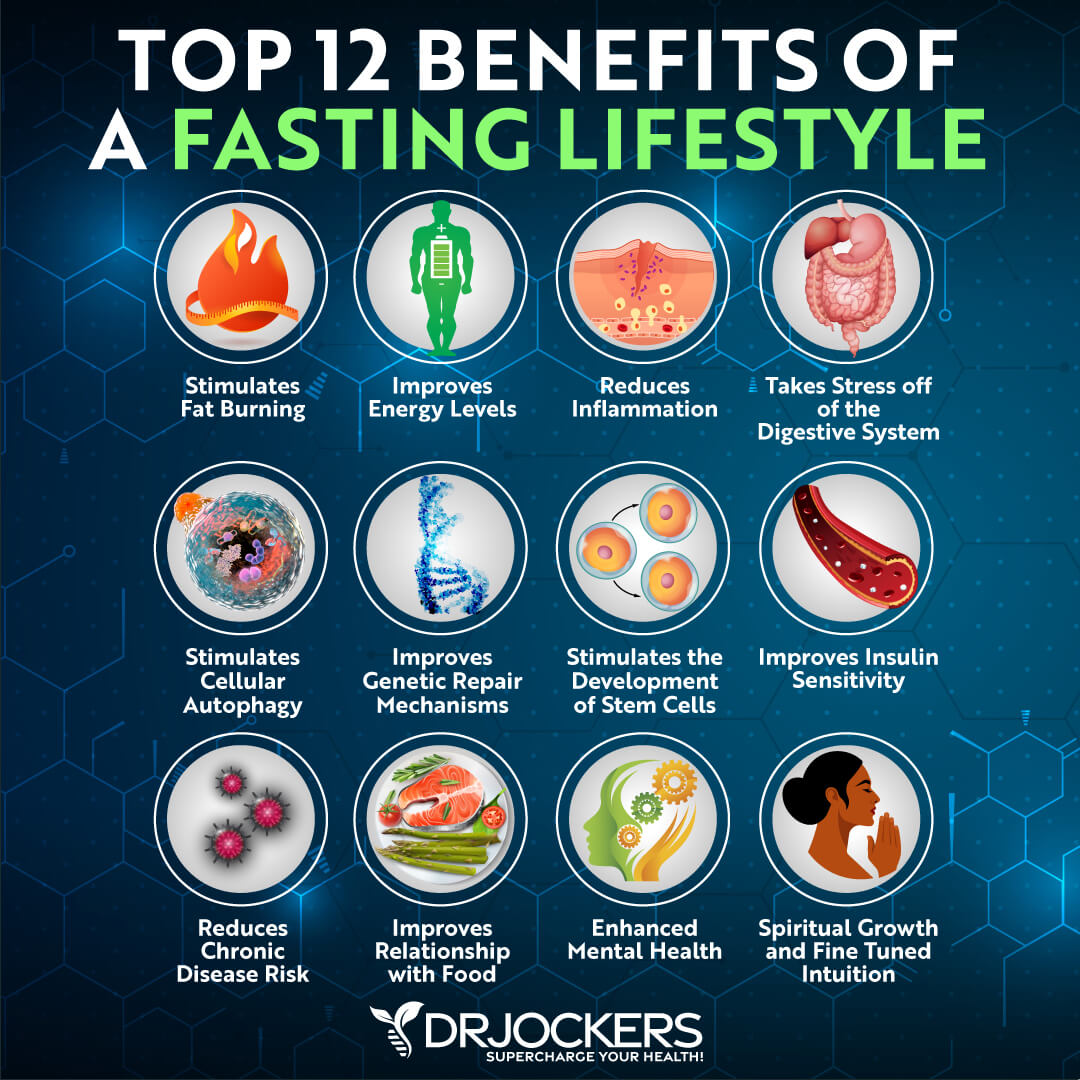
4. Alternating Showers
Taking alternate shows has an array of health benefits, including improving chronic pain, increasing energy, improving your mood, and boosting your brain function. Short periods of intense heat and cold exposure can promote skin autophagy by putting a major stressor on your body forcing it to adapt quickly and achieve homeostasis again. Alternate showers can help your body to become stronger and more resilient (30).
Hot water can improve inflammation, open up your pores allowing them to remove clogs and dirt, and improve your overall health. Cold water, on the other hand, can close up your clean pores and help them stay clean a healthy. The alternation between hot and cold showers can also improve your circulation and blood flow, which can help to rejuvenate your skin (31, 32, 33, 34, 35, 36, 37).
To practice alternate showering, it is a good idea to end your shower with 30 to 60 seconds of cold water. You may also alternate between hot and cold several times, just make sure to end with a cold shower. You may also experience the same benefits if you take a cold shower or jump into a cold pool after soaking in a hot tub or spending some time in an infrared sauna. You can learn more about alternate showering here.

5. Regular Exercise
As a human being, you are meant to move your body. Did you know that an average American spends 13 hours a day sitting? Combined with 7 to 8 hours sleeping, that’s 20 to 21 hours without movement. However, being inactive is not good for your health (38).
Regular exercise can improve your mitochondrial health, sleep, and immune system. By boosting your immune system and lowering inflammation, it lowers the risk of skin inflammation and infections as well.
High-intensity interval training and resistance training, especially while fasting, can ramp up autophagy in your body. Increasing muscle mass can lead to firmer skin and reduce the visibility of cellulite. Sweating allows your body to get rid of toxins, clear your pores, and maintain clear skin. Exercise can lower the production of cortisol, which can cause skin problems, including wrinkles, sagging, and acne (39, 40).
Most importantly, increased happiness from regular physical activity becomes apparent on your skin as well. A heart-pumping aerobic exercise or another hard workout can lead to an instant post-workout glow.
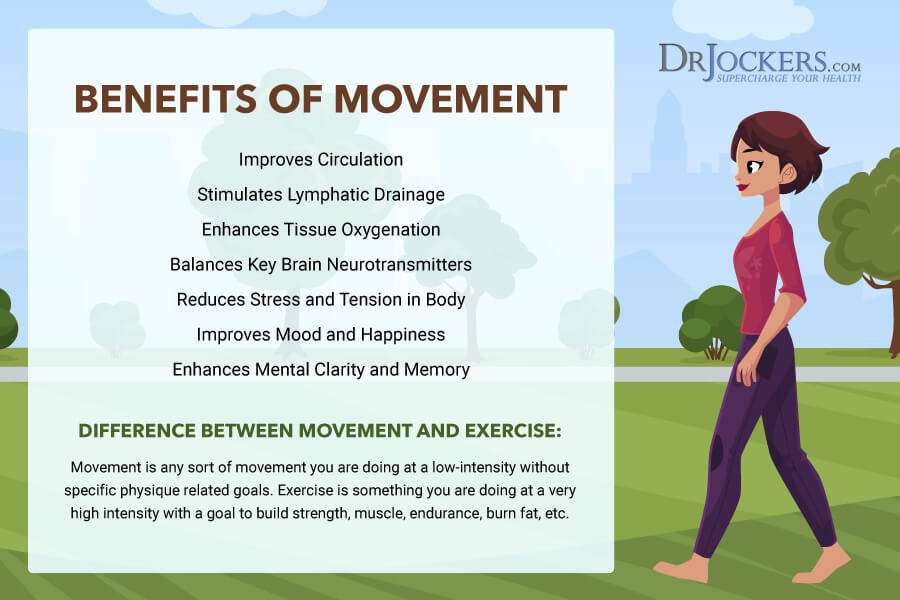
6. Get Outside and Good Sun Exposure
Spending time outside in nature and getting good sun exposure is an opportunity to get some exercise without noticing, breathe in some fresh air increasing your oxygen consumption, and boosting your mood. Spending time outside on the sun is also a great way to reduce stress, lower cortisol levels, and decrease inflammation in your body. Remember, lowering inflammation is crucial to rejuvenating your skin. Your skin also uses sunlight to create vitamin D, which is an essential vitamin for your overall health (41).
However, when you are in the sun, it’s important to take some precautions. Spending time outdoors and getting sunshine is important and good, however, it is crucial that you don’t burn and protect yourself from UV. Wear natural, protective sunblock. Don’t stay out too much, and enjoy plenty of time in the shade as well. Wear protective clothing as needed. If you practice caution, you and your skin health can enjoy the benefit of some sunshine.
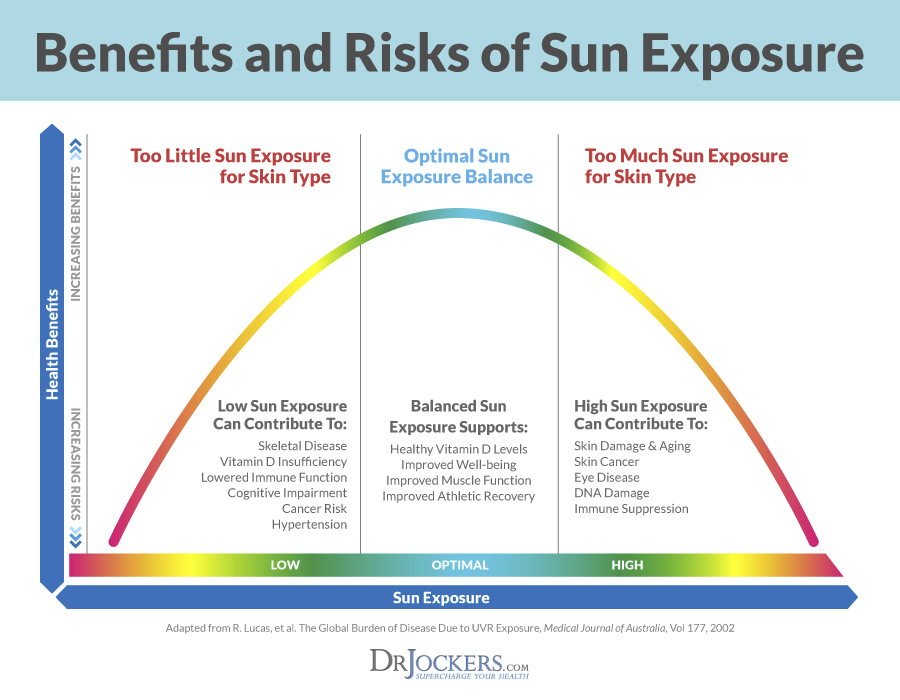
7. Good Sleep and Stress Reduction
Getting a good night sleep and reducing stress is essential for your overall health. Just think about it, when you are tired and stressed, those bags under your eyes become more visible, and you may notice more pimples, skin infections, or dryness.
Maintaining a healthy sleep cycle and circadian rhythm is closely tied into autophagy. Insomnia, lack of sleep, and fatigue can increase your risk of inflammation and chronic disease. Being stressed increases cortisol in your body, which can lead to inflammation, disease, and premature signs of aging that are visible on your skin. On the other hand, reducing stress and sleeping plenty can encourage your skin to rejuvenate and create new, healthy, and youthful looking skin cells (42).
Develop a regular sleeping schedule and routine to support your circadian rhythms. Make sure to get 7 to 9 hours of sleep each night. Reduce stress through meditation, yoga, relaxation exercises, movement, time in nature, and other calming activities. Avoid stressful situations whenever possible and learn coping skills to respond to stress better. To learn more about the common causes of bad sleeping habit and how to reverse them, check out this article.

8. Autophagy Enhancing Herbs
Utilizing the power of autophagy herbs is one of the best ways to rejuvenate your skin. They are rich in nutrient, antioxidants, and polyphenols thus can effectively support your skin.
Green tea is not only delicious, but it is rich in polyphenols and nutrients that can improve your health. Catechins, a specific type of polyphenol, can help to regulate your hunger hormone helping your autophagy-supporting fast (43, 44).
Besides green tea, there are other herbs that are rich in polyphenols that suppress the mTOR pathway and activate the AMPk pathway to induce autophagy. Some of my favorite autophagy herbs include quercetin in red onions and elderberries, carnosic acid in oregano, sage, and rosemary, EGCG in dark chocolate, 6-shogaol in ginger, curcumin in turmeric, resveratrol in blueberries and grapes, and citrus bergamot in Earl Gray tea (45, 46, 47).
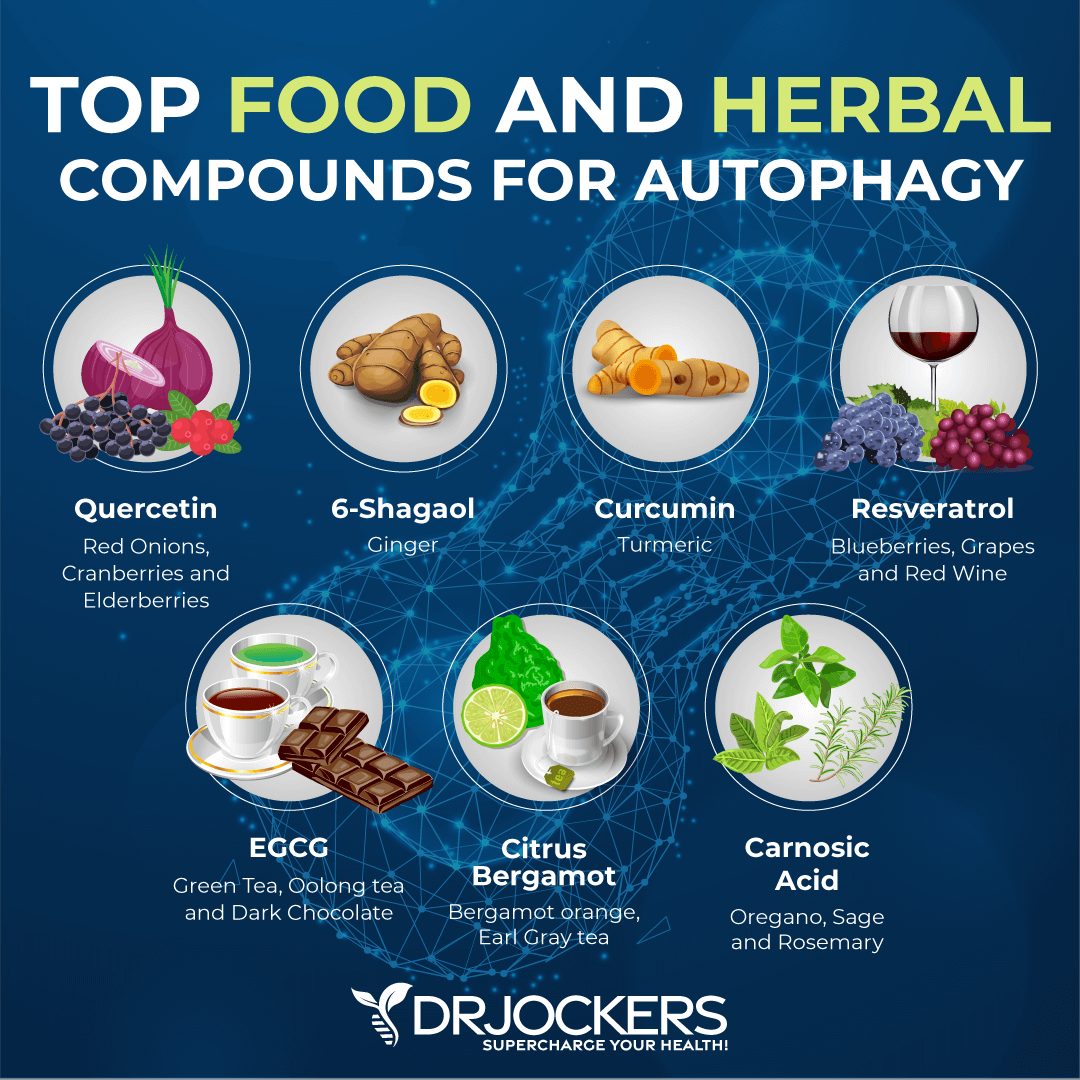
9. Autophagy Activating Supplements
In addition to autophagy herbs, I recommend utilizing autophagy activating supplements. One of my favorite supplements that supports skin autophagy is Inflam Defense™ because of its powerful ingredients, turmeric, ginger, boswellia, quercetin, and rutin.
Turmeric is an herb native to Southeast Asia known for its remarkable anti-inflammatory benefits. Thanks to its active compound, curcumin, it can effectively reduce inflammation, oxidative stress, and pain, and as a result, improve your skin (48, 49. 50).
Ginger is another potent superfood that can effectively reduce inflammation and pain. It can effectively reduce free radical damage and improve your health through antioxidants (51).
Boswellia is also referred to as frankincense. It can effectively suppress the production of key inflammatory molecules and reduce the risk of health problems (52).
Quercetin and rutin are two active bioflavonoids that can improve your immune response. They can reduce inflammation and oxidative damage improving your overall health.
Inflam Defense™ is a powerful supplement that can modulate the inflammatory response in your body, reduce oxidative stress, support autophagy, and help to rejuvenate your skin. Through regular use, you can see a true difference in your skin complexion and overall health. You can learn about there anti-inflammatory herbs in Inflam Defense™ that can help to rejuvenate your skin here.
10. Proper Skin Care
When it comes to your skin health, you cannot forget about proper skin care. Natural skin care is not difficult. All you have to do is to pay attention to the few simple tips below.
What to Avoid to Rejuvenate Your Skin:
- Long, hot showers
- Soap-free cleansing bars
- Anything with alcohol and perfumes
- Lanolin-based creams, lotions, ointments, etc.
- Toxic ingredients you’ve learned about earlier that can have a harmful effect on your skin
What to Do to Rejuvenate Your Skin
- Eat a nutrient-dense diet and drink plenty of fluids to stay hydrated. Avoid alcohol, sugary drinks, and sodas. Drink 2 to 3 quarts of water daily. You can add lemon or lime as well. You may also add herbal tea or green juice to your routine. You can learn about a healthy anti-inflammatory diet that supports your skin here.
- Keep your home cool and humid to avoid dry skin reactions. Wear gloves in cold weather, and sunblock and protective clothing in hot weather.
- Wear cotton clothes whenever possible. Use natural, mild detergents.
- If you notice a rash after shaving, do not shave until its completely healed. Avoid perfumed after-shave.
- Start loving moisturizers. Natural moisturizers can prevent water loss by layering an oily substance over the skin to keep the water in or by attracting water to the outer layer from the inner layer of your skin. I recommend Purity Woods Age Defying Dream Cream which uses organic ingredients that help to soothe the skin and activate skin autophagy and moisturization.
Final Thoughts on Skin Health
Your skin is the largest organ that serves as a protective layer and performs essential tasks for your body. The health of your skin is important for your overall health. Your skin protects you from viruses, bacteria, and UV rays. It produces vitamin D, helps to regulate your temperature, and help you react to important changes affecting your body.
Taking care of your skin is important and you can do it naturally. Optimal hydration, eating an anti-inflammatory diet with trace minerals, using autophagy herbs, intermittent fasting, sleeping plenty, spending time outdoors, alternate showers, reducing stress, and healthy skin care routine are all important for your skin health.
To rejuvenate your skin, I recommend Inflam Defense™, an autophagy-activating, an anti-inflammatory supplement that can protect your skin and overall body. To support a natural and healthy skincare routine I recommend Purity Woods Age Defying Dream Cream.
Following these 10 simple strategies to rejuvenate your skin, you can experience visible benefits. Your friends and family will compliment you for your glowing skin, and your body will thank you for your loving care as well.
Purity Woods Age-Defying Dream Cream
Healthy, radiant looking skin is certainly a confidence booster. It is a goal that everyone tries to achieve (and keep) throughout their lives. As we begin to get older, there are millions of tricks, tips and procedures out there to maintain the same healthy-looking skin we had when we were younger.
That’s why I would like to share my top choice for keeping skin looking young and healthy – the USDA Certified Organic Age-Defying Dream Cream from Purity Woods.
This anti-aging cream is truly a game changer when it comes to achieving and KEEPING your skin looking and feeling spectacular. Now you can save up to 38% on this amazing product, simply click here to learn more!
Red Light Therapy
Red light therapy (RLT) is a powerful therapeutic technique and an alternative healing method. It uses red low-level wavelengths of light for a variety of therapeutic purposes, including wound healing, scars, and other skin issues, inflammation, pain, hair growth, and sleep quality (53).
One of the main reasons people use red light therapy is for its skin health benefits. A study on the benefits of the stimulating, repair, and skin benefits of RLT found that it may increase collagen production, fibroblast production, mRNA and circulation between skin cells. As a result, RLT may help skin elasticity and facial texture, reduce fine lines and wrinkles, and lower free radical damage (53).
Red light therapy may also help to treat acne. Just like sunlight it may reduce affect sebum production. However, too much sun exposure can be problematic because of the ultraviolet (UV) and UVB rays, making RLT a great option. Another study has found that it may improve complexion and the overall feeling of the skin, and help to rejuvenate skin cells (53, 54).
If you are looking for a high-quality red light therapy device, I personally use and highly recommend Mito Red Light Therapy Device. It is a third-party tested device with the highest power on the market. Use the coupon code DRJOCKERS at checkout to save 5% on the MitoRed product line.

Red Light Therapy Face Mask
If you are looking for red light therapy benefits specifically for your face, I highly recommend this HigherDOSE Red Light Face Mask. It offers a functional cordless design, which is very convenient. You can use it anywhere in the house and take it with you on trips. It helps to rejuvenate your skin and may be great for acne scarring, scarring, fine lines, wrinkles, and your overall skin tone.
Even just one session can make you feel more rejuvenated and fresh in your skin. However, if you use it regularly, you may notice a visible difference in your skin. Less scaring, fewer fine lines, fewer wrinkles, and more importantly, a visible glow are among the potential benefits.
I highly recommend that you add using a HigherDOSE Red Light Face Mask to your daily routine. This is a great time for relaxation, meditation, and some well-deserved ‘me time’. Use the coupon code DRJOCKERS20 to save 20% off on HigherDOSE products including the Red Light Face Mask.
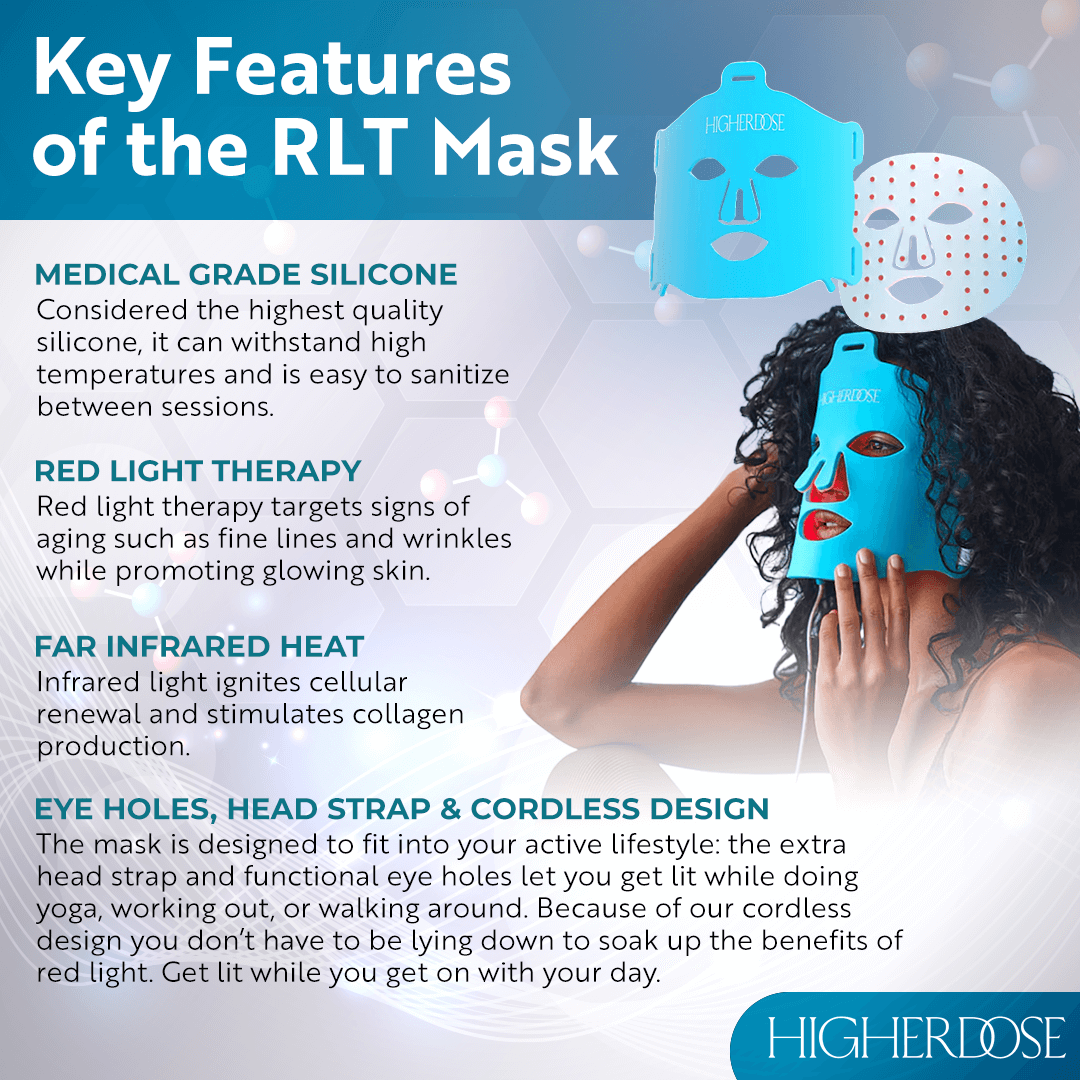

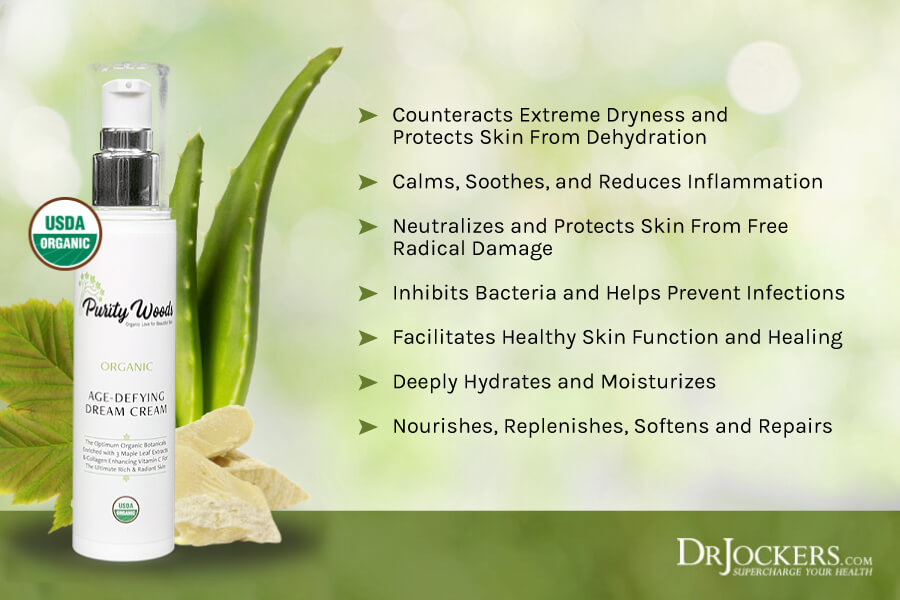
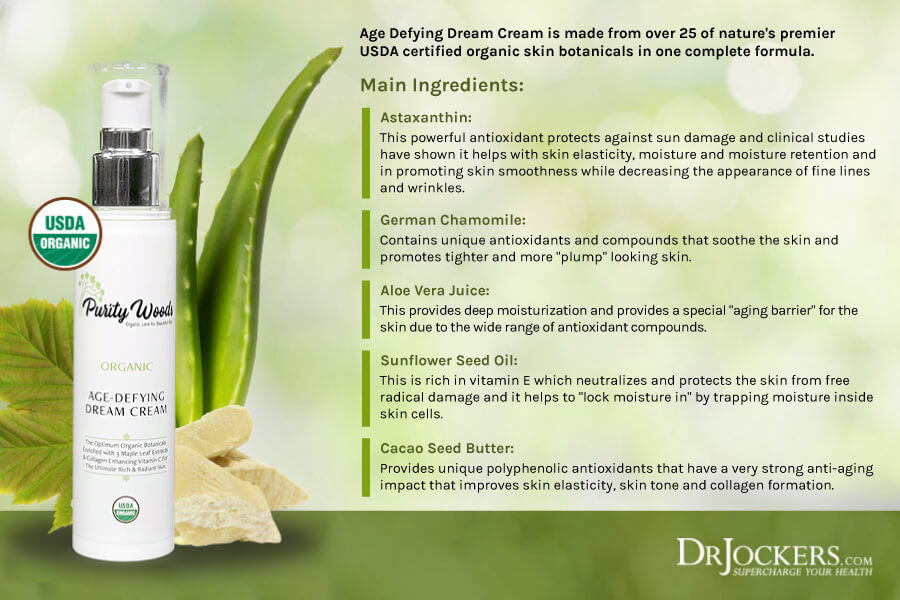
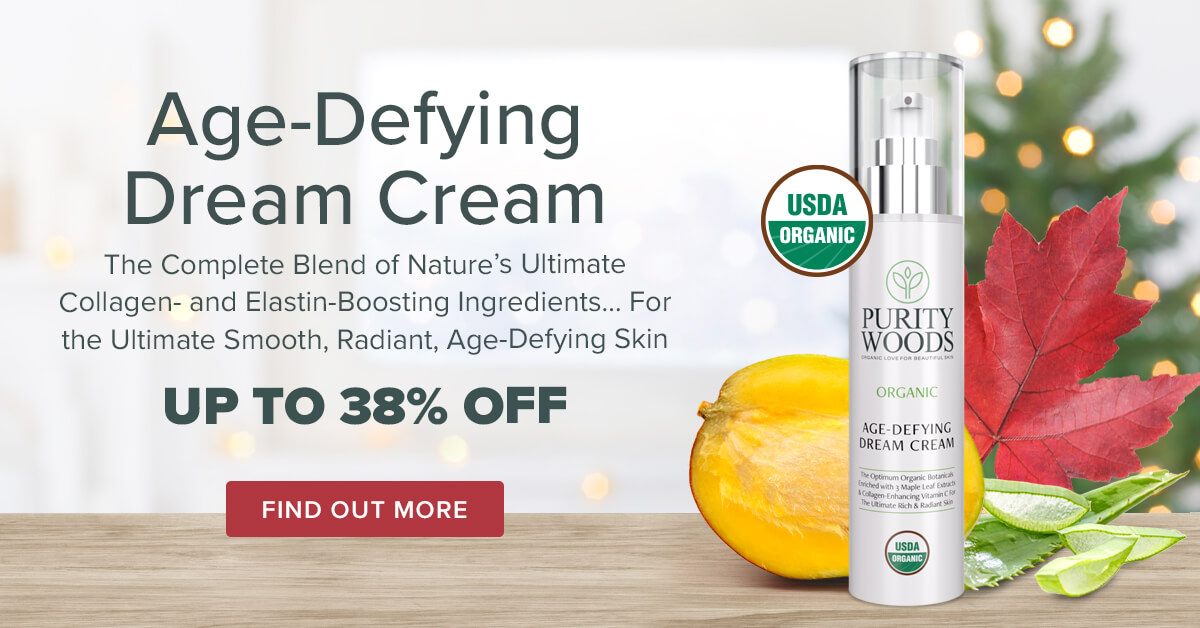



I like your articles, talks and info. What about not using plastic packaging? Bottles of herbs and skin care in plastic-use it , throw out skin care tubes, bottles to recycle. But what happens in recycle? More energy to make what? I am frustrated with all the plastic. My practice has way too much plastic. I would love alternative. How can we reuse bottles? UV light, clean with minimal water without chemicals so can be reused or put on trees? Any awesome ideas? Thanks for your time, Reina
Hey Reina, Thank you for sharing. You are correct, it is first best to avoid plastic if we can. There are many great websites that focus on DIY creative recycling ideas and innovate recycling companies focused on reducing waste and investing in charities. Some schools even accept certain goods like cartons and plastic bottles for educational activities! Blessings!
Gluten from modern varieties of wheat (which is the vast majority of the wheat consumed today) would be at the top of my list of foods to avoid, followed by the 7 you have listed. Dr. Faisano has pointed out how gluten causes cross reactivity to other foods like dairy, nuts and fish.
https://erdakroft.com/Blogs/Entries/2014/2/23_Gluten%2C_The_Poison_In_Our_Modern_Daily_Bread.html
Hey Krofter, Yes, you are correct. I write in more detail about cross-reactive immunology of gluten in this article: https://drjockers.com/gluten-sensitivity-brain/
Excellent and thorough article as expected again David!!
Thanks Cher!
Hello: what is your opinion on the cause of acne rosacea… had it since childhood. I’m fair and freckled with age spots most of my life because I inherited bad skin… would like your opinion on lasering rosacea…thanks.
Hey Robyn, This may be caused by metabolic abnormalities and other inflammatory conditions including gut issues. Read this article on a list of ways to overcome it naturally: https://drjockers.com/beat-eczema-acne-psoriasis/
Yep, applies to me: gut issues, depression, hormone imbalances, poor sleep…thanks for info:-)
You’re welcome Robyn! Blessings!
there is mineral which hardly found in articles of doctors which clears the skin, eliminates asthma, helps with autism, detoxes heavy metals, improves bowl movement, improves nail health and obviously much more.. it is called sulfur! i saw the picture on ali express of before and after and got lured in…got a sulfur cream, and applied it on the hands of my daughter which has these annoying bulging dots, and it reduced them after a few applies. yesterday i had a cut and it was annoyingly pulsing, i applied the cream and got relief instantly..
Hey Vacheslav! I’m glad to hear that worked as a pain reliever for you! You are absolutely correct- sulfur is a a critical compound for human health! I go into more detail about the benefits of MSM Sulfur here!
A few years ago, my sister (a senior citizen) moved from rainy Washington to Reno, and she insists that the poor condition of her skin is largely due to the dry desert air. So my question is: All other things being equal, how big of an impact does a dry climate have on the condition and appearance of skin (particularly wrinkles and sagging)? If the impact is significant, then what is the best countermeasure: internal hydration, or topical moisturizing? (Note: I have shared your article with her, so she can learn about the other contributing factors, too. I hope she reads it.)
Hey Terri, Optimal hydration is of first importance! She may also find the strategies to improve skin in this article very helpful!
Our skin has a microbiome the same as our gut does. It can be either a healthy or unhealthy one. Sometimes it can be healthy in one area and unhealthy in another.
One quick and easy way of checking on the health of our skin microbiome generally is to ask, “After working up a sweat, do I stink and need to shower immediately ?” If the answer is “Yes,” that’s almost always due to an unhealthy skin microbiome, especially in the armpits. Commercial antiperspirants, deodorants and antibacterial soaps can be one cause of that.
It appears as if, just like in the gut, there are some good microbes and some bad microbes on everybody’s skin all of the time. The important thing is to keep them in balance, with the good guys predominating. Washing, even with a good natural soap, depletes the population of both the good and the bad guys. It seems as if after a thorough washing the bad guys often grow back faster, with the good guys eventually taking over only in the long run. But that means giving them a fighting chance to do so. Washing them all away on a daily basis can keep that from ever happening; so washing off the stink after sweating, and most of the good microbes along with it, on too regular a basis can actually be unhealthy for the skin. It’s only the bad guys that are capable of creating the stink, not the good guys and not our own bodies.
One workaround for that that worked for me was to simply skip the soap, especially under my arms, on every other shower for a while, then on two out of three showers, and eventually six days per week. I’ve finally reached the point where I can sweat like a pig and nobody can detect any body odor on me at all for hours afterwards. I had a great uncle who was a hard working farmer in remote Iowa half a century ago and who bathed only four times a year, and he never stank at all.
Wow! Thank you so much for sharing your personal and family experience with skin health Greg! We are so blessed to have you as part of our DrJockers.com community!
Why are soap-free cleansers not good for the face?
Many have toxic chemicals that cause problems.
After reading several of David’s highly detailed, in-depth articles, and having felt inspired by Dr. Edward Group’s 18-day fast, I decided to do a 20-day water fast to try and clear up a mysterious mild skin rash on my face, neck, shoulders and upper back. Miraculously, 75% of the rash had disappeared, even this never ending dandruff had totally healed up. 2 weeks later, I ate 150g of Organic Times Organic Dark Chocolate Macadamia Nuts + 150g of Organic Times Organic Dark Chocolate Coffee Beans. I don’t understand why this small amount of organic chocolate made me so sick. Most noticeable symptom: It did something to my lungs. I felt starved of oxygen. I was gasping for breath. I felt extremely light-headed and dizzy all throughout the night. I felt like I was going to pass out. I couldn’t sleep because the sugar rush was intense. My mind was racing. It felt like I was on drugs. Amazingly, I did a total of 6 separate large bowel movements within the span of 10 hours. Bowel movement 5 and 6 was all diarrhea. I haven’t had diarrhea in years. I believe that was the poison from the chocolate exiting my body. In order to better understand the inner wiring and mechanics of my body, I wish I knew the exact ins and outs of why my health suddenly went haywire after eating this chocolate. Other symptoms include: A hard and fast beating heart, dripping nose, sneezing and tightness in my chest. Also of note: I ate the chocolate while watching a new release movie. This A-grade movie got me feeling overly excited. My adrenaline was high. I believe this action-packed movie may have acted as a catalyst that offset all these symptoms. After eating the chocolate and other supposedly organic steak and tomato and chilli sauces that contain sugar, the rash has come back with a vengeance. My face is burning. My chin right now is burning. Today is day 1 of eating nothing but 1 meal a day of raw organic vegetables in a salad dish. If sugar is the main culprit as to what ails me, then it’s only a matter of time until I figure it out. I sense another serious fast or elimination diet in the works if this rash refuses to clear up again soon. Yep!
Thanks for sharing Mark! Yes it may have been the sugar, food sensitivity or it could also have been too much long-chain fats for your liver/gallbladder and you struggled to produce enough bile to metabolize it. We wish you all the best on your health journey!
You have to start out young as none of the above recommendations will have a significant effect after visible aging occurs.
In the 1980s, I read that 75% of skin damage was due to UV ( now, specifically UVA& UVB) so the cheapest thing you can do is use a sunscreen, daily, always. Yes, choose one without any of the chemicals mentioned in the article above but then it becomes expensive.
Despite diet and hydration habits ( and I believe we should eat the best diet possible), if you want to stay as wrinkle free as possible: use Retin-A early in life, a sunscreen and the best home RF device you can afford. You’ll be pleased in the end.